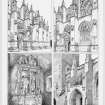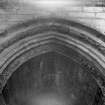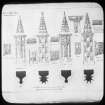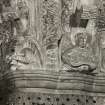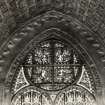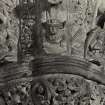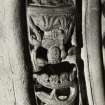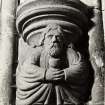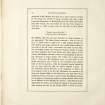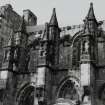Scheduled Maintenance
Please be advised that this website will undergo scheduled maintenance on the following dates: •
Tuesday 3rd December 11:00-15:00
During these times, some services may be temporarily unavailable. We apologise for any inconvenience this may cause.
Roslin, Roslin Chapel
Chapel (15th Century)
Site Name Roslin, Roslin Chapel
Classification Chapel (15th Century)
Alternative Name(s) Rosslyn Chapel; Roslin Episcopal Chapel; St Matthew's Collegiate Church
Canmore ID 51812
Site Number NT26SE 22
NGR NT 27489 63073
Datum OSGB36 - NGR
Permalink http://canmore.org.uk/site/51812
First 100 images shown. See the Collections panel (below) for a link to all digital images.
- Council Midlothian
- Parish Lasswade
- Former Region Lothian
- Former District Midlothian
- Former County Midlothian
About 1446 construction of Roslin Chapel began at the instruction of Sir William St Clair. Although only the choir and a lower-level sacristy were completed by his death in 1484, he originally intended to build a cruciform church.
The quality and quantity of the decorative stonework makes Roslin Chapel exceptional. Carvings cover almost every surface, interior and exterior. The carvings do not only represent religious themes, but include mystical animals, elaborate foliage and heraldry.
Information from RCAHMS (SC) 5 July 2007
McWilliam, C 1978
(NT 2749 6306) Roslin Chapel (NR)
OS 6" map (1966)
Roslin Chapel, formerly St Matthew's Collegiate Church: This building was erected by Sir William St Clair, building starting about 1446, and continued until his death in 1484. It was intended to comprise a choir, nave and transepts, but only the choir was completed.
The aisles are returned across the E end, forming a processional aisle of four bays, beyond which are three chapels, while from the S bay a stair descends into a crypt-chapel or sacristy extending SE of the main building. The E walls of N and S transepts remain, but nothing further seems to have been built. The remarkable elaboration of ornamental detail have been built. The remarkable elaboration of ornamental detail gives this an exceptional place among Scottish churches of the period. The choir, with a lofty clerestory, is covered with a pointed barrel vault divided into bays by cusped transverse arches. The structure was defaced by a mob in 1688; no repairs were carried out until 1736. A further restoration took place in 1861-2. It probably did not have a collegiate constitution until the early 1450s (I B Cowan and D E Easson 1976).
RCAHMS 1929, visited 1928; D MacGibbon and T Ross 1897
Roslin Chapel is generally as described. It is no longer used for worship.
Visited by OS (SFS) 29 October 1975
Scheduled as Rosslyn Chapel, ecclesiastical and related remains.
Information from Historic Scotland, scheduling document dated 7 October 1996.
NT 275 631 Groundworks were monitored on Chapel Loan between College Hill and the new visitor centre to the NW and NE of the chapel respectively. The foundations of the visitor centre, a stables/coach house of two phases (17th and 19th century), were found to have been built of reused dressed ashlar and other worked stone, with a single protruding base course built directly onto subsoil.
At the chapel, a services access trench was excavated archaeologically at the foot of the pier at the junction of the partly completed N transept and the existing E wall of the crossing tower. Here the founds of Kerr?s baptistery of 1880-81 were exposed, overlying the 15th-century founds of the pier itself. The latter were found to be of substantial construction, the pier foot resting upon two courses of massive roughly hewn red sandstone blocks set into natural.
Further work to the visitor centre permitted a full assessment of the structure and its flooring which, in the smaller eastern bay, consisted of parts of a cobbled stable floor with drain, perhaps of the 17th century. The larger western bay had been enlarged in the 19th century retaining earlier S and E walls, the latter still displaying a crow-stepped gable head. Much of the fabric of the visitor centre from both phases consisted of reused dressed ashlar, moulded and sculpted sandstone blocks. The protruding found course within the western bay had been largely built of the massive sandstone blocks seen at the chapel pier base.
Deconstruction of the walling dividing the two bays revealed the fossilised jamb of a gate pier and some 20 carved stones ranging from simple but substantial arcade voussoirs, to moulded jamb stones and a number of sculpted stones. Of the latter, two appear similar to 17th-century details of the surviving wing of Rosslyn Castle, while two further fragments form a complete finial or dormer pediment. This takes the form of a circular rosette surmounting a triangular body that frames a carved panel of four leaf- or petal-like lobes (Addyman 1998, fig 44). An identical finial can be seen upon the exterior wall-head of the N aisle of the chapel, although this itself may have come from ruined parts of the castle.
The creation of the new car park involved the grading of an area of open field at the corner of Chapel Loan and the lane to Rosslyn Castle. A series of very substantial pit-like features were revealed. These contained masonry and other debris, wine bottles and domestic rubbish that can most likely be associated with the use of College Hill as an inn during the later 18th and earlier part of the 19th century. The foundation course of what was interpreted as a barn was revealed along the side of the castle lane. Its masonry contained finely worked blocks of robbed medieval ashlar, while an internal sub-division and possible barn entrance into the field to the W were its only discernible features. A later well-constructed boundary wall was erected running from the N wall of the barn. The masonry of each was overlain by a later 19th-century domestic rubbish dump. The barn can probably be associated with the use of College Hill and may similarly date from the mid- to late 18th century.
A report will be lodged with the NMRS.
Sponsors: Historic Scotland, Rosslyn Chapel Trust.
T Addyman 1998
NT 2749 6306 In advance of ongoing conservation works the sacristy was recorded by a stone-by-stone survey. This revealed that while the interior was largely of 15th-century construction, only the lower walls and E window survived from this phase on the exterior. The upper walls had clearly been substantially rebuilt, perhaps in documented repair works in the earlier 18th century, and incorporated a number of reused carved medieval stones. The parapets had seen a second phase of reconstruction. Repairs to the adjacent boundary wall on the N side of the sacristy revealed that it too contained numerous architectural fragments, some of which were recovered during repairs.
Service trenching on the N side of the sacristy revealed that the medieval lower parts of the existing 'cell' walls had extended further to the N. Trenching on the S side of the sacristy revealed the lower courses of ashlar work and the footing of the SE angle of a further chamber that had existed in that area.
Service trenches along the E gable wall of College Hill revealed the footings and interior floor make-up levels of a range of buildings known to have been demolished in the later 19th century. Repairs within College Hill itself revealed the partly damaged remains of an early 18th-century moulded fireplace surround within the W ground-floor room, W wall. Still adhering to the cheeks of the fireplace were a number of delftware tiles, hand-painted with pastoral scenes in underglaze blue.
Sponsors: Historic Scotland, Rosslyn Chapel Trust.
T Addyman 2001
Standing building recording; watching brief; evaluation NT 274 631 A 3-D survey of the interior and exterior elevations
of Rosslyn Chapel (NT26SE 22) was carried out between April and December 2005 using a laser scanner, to aid the condition assessment prior to renovation.
A watching brief was also carried out during the excavation of six small test pits prior to bore holes being sunk within the grounds of Rosslyn Chapel. The test pits were excavated to a depth of 1m, but no significant archaeological features or artefacts were encountered.
Archaeological supervision of machine-stripping over the extent of the proposed car park area to the W of Rosslyn Chapel was also carried out. The area was stripped down to natural subsoil. No significant archaeological features or artefacts were encountered.
Archive to be deposited in NMRS.
Sponsor: Page and Parks Architects.
G Cavers, V Clements and D Wilson 2005
Architect: Henry Kerr (restoration)
PRINTROOM:
W. SCHOMBERG SCOTT PHOTOGRAPH COLLECTION Acc. No. 1997/39
View of exterior, the buttresses - 4 prints.
Detail of the doorway dated, 1622.
INGLIS PHOTOGRAPH COLLECTION Acc. No. 1994/90
'Rosslyn Chapel. North Front. 472. AI'
LIBRARY CUTTINGS:
The Scotsman 12/5/93, 'Knights in the Chapel of Love' - article
The Scotsman 15/5/93, 'Rosslyn chapel needs extenxive restoration' (sic) - letter from Margaret Macaulay and photograph.
Articles missing at time of upgrade, 22.6.1999
EXTERNAL REFERENCE:
NATIONAL ARCHIVES OF SCOTLAND:
Sketch of frieze on the North side of the chapel at Roslin and a description of the frieze on the South side, (18th).
GD 18/5111
Mismanagement of repair work: John Baxter is blamed for dilatoriness by Col. James St Clair in his letters to Sir John Clerk who is anxious to encourage Col St Clair to complete the repair work,1738-1742. GD 18/5010
Repair of the roofs of Roslin Chapel and the school of Roslin Chapel: Payment of ?3.10.0 to Mackenzie Buchan, mason. Roslin accounts, 1797. GD 164/Box 79/832/7
Repair of the roof of Roslin Chapel: Payments for repair work, roofing and sarking. Mason: William Irvine. Roslin Accounts, 1805. GD 164/BOx79/832/15.
Repair of Pillar in Roslin Chapel: Payment to Mackenzie Buchan, mason. Roslin Accounts, 1796. GD164/Box79/832/6
Making of a new window in the Roslin Chapel and glazing it: Payment to William Irvine. Roslin Accounts, 1804. GD 164/Box79/832/14.
Repair of the roof of Roslin Chapel: Payments to mason, wright and slater. Roslin accounts, 1796. GD 164/Box 79/832/6.
Glazing of Roslin Chapel and Castle: Payment Roslin Accounts, 1803. GD 164/Box79/832/13.
Proposed repairs to Roslin Chapel: William Burn, Architect, (1789-1876) is asked to examine the Chapel and send a report to the Earl of Rosslyn. He is to state what repairs are required and to examine the foundations, the projecting crypt and the roof. Memo, 1836. GD 164/Box57/461.
Proposed alteration to the roof of Roslin Chapel: It is the Earl of Rosslyn's intention to remove the two side roofs and to re-roof the side aisles 'thereby discovering the whole of the window and rendering the appearance of the roof more in conformity with the original plan'. Memo, 1836. GD 164/Box57/461.
Re-roofing of Roslin Chapel and proposed repair of pinnacle: The Earl of Rosslyn wishes William Burn to produce a specification for the proposed alterations and estimates for re-roofing 1) with stone as originally constructed, 2) with lead 3) with zinc and 4) with cement. Further Mr Burn is to consider the probable expense of repairing the damaged pinnacle according to the original drawing. Memo, 1836. GD 164/Box 57/461.
Repair work at Roslin Chapel: Payments to D. Gilmour amounting to ?335.6.6 for repair work. Payment to John Alison, Dundee of ?42.13.0 for pavement for the roof. Accounts: Messrs Dundas and Wilson with the Rt. Hon Earl of Rosslyn,
1837-1838 GD 164/Box 45/358.
The heating of the Chapel: Letter from David Bryce concerning the best plan for heating, 1861. GD 164/Box12/21
Design for hanging lights: John Hardman and co. Rosslyn Papers, 1861-1864. GD 164/Box12/21.
David Bryce writes to explain to the Earl of Rosslyn that Baxter would not be able to do all in time and would require to work a week of two longer. The window sashes are being prepared and the Chapel is almost dry, 1861. GD 164/12/21.
Designs for a lectern (5): John Hardman and co. Rosslyn Papers, 1861-1864. GD 164/12/21.
Letter concerning stained glass windows: John Hardman and Co. offer to forward sketches and an estimate to the Earl of Rosslyn, 1864. GD 164/12/21.
Letter from David Bryce: He advises that advises that MacGibbon's estimate should be accepted particularly as he had done all the other things at Rosslyn Chapel, 1861 GD 164/Box12/21.
David Bryce describes the pillar on the opposite side and corresponding with the Apprentice Pillar: 'It has at one time been ornamented not in a spiral form but with upright ornament which has been partly cut out and new stone introduced, and other stones where entire being plastered over. The introduced plain stone is white, the original is red', 1861. GD 164/Box12/21.
Letter concerning ventilation and seating from William Burn: He approves of having plain deal benches and he encloses a sketch of a plain bench end, 1861. GD 164/12/21.
Seating for Roslin Chapel: Letter from John Reddie and Co. He quotes a price for seating the 'same as in nave of the Cathedral designed by Mr. Butterworth Esq. London', February, 9th, 1861. GD 164/Box 63/540/1.
Seating and ventilation for Chapel: Letter from William Burn, Architect, (1789-1870) to the Earl of Rosslyn. He advised on ventilation and expresses his approval of having plain deal benches. He enclosed a sketch for a plain bench end, April 9th, 1861. GD 164/Box 63/540/4 and 5x.
Measurements and rough sketch of Roslin Chapel: Measurements of organ space, Communion table etc. and rough plan of the layout of the chapel. N.d. GD 164/Box63/540/7-9
Proposed alterations to the burial vault at Rosslyn Chapel: Letter from David Bryce, Architect, (1803-1876) to the Earl of Rosslyn. He wished to cover over the grave in the centre compartment of the Burial Vault and then form a catacomb on each side of the space. The railing, he considers, should be portable and should extend between the pillars but not touching them and be fixed into iron or brass sockets into the stone work. It should not be higher than 3'6" and very light and should return along the old seat which forms the wall of the stair down. He had shown all this on his plan. 1859 GD164/Box 69/644/1.
Repair of the Chapel: Letter from David Bryce, Architect, (1803-1876) to the Earl of Rosslyn. He explains that Baxter would not be able to do all this in time and would require to work a week or two longer. The window sashes are being prepared and the Chapel is almost dry. He outlines the best plan for a heating system, June 4th. GD164/Box63/540/6.
Proposed repairs at Roslin Chapel: Letter from David Bryce, Architect (1803-1876) to the Earl of Rosslyn. It accompanied drawings of the stone work of the proposed repairs. He included a drawing plan moulding for the cope stone of the altar and one of a splay moulding. There had been a small altar at the window over the stair down and this was prepared to restore and also to put a landing place a landing place over the stair sufficiently broad to admit of a person standing in front of this altar, 1859. GD164/Box69/644/1.
Seating for Roslin Chapel: Letter from Cox and Son to the Earl of Rosslyn. William Burn, Architect (1789-1870) had asked them to send a number of designs, March 1st, 1861. GD 164/Box63/540/2.
A pillar in Roslin Chapel: Letter from David Bryce, Architect (1803-1876) to the Earl of Rosslyn. He describes the pillar on the opposite side and corresponding to the Apprentice Pillar, 'It has at one time been ornamented not in a spiral form but with upright ornament which had been partly cut out, new stone introduced and other stones plastered'. June 4th, 1861. GD 164/Box63/540/6.
A lectern for Roslin Chapel, Designs (5): John Hardman and Co. Metal Workers, King William Street, Strand, 1861-1864 GD 164/Box63/540/14-18.
Statuary for Roslin, Virgin and Child: Sculptor, Frances John Williamson (1883-1920).
Mr Williamson has received the measurements of the niche at Roslin Chapel and he realises that the figure of the Virgin must be no more than 4'. Letter to the Earl of Rosslyn, 1874 GD164/Box 65/591/34.
Stained glass windows for Roslain Chapel: John Hardman and Co., New Hill, Birmingham offer to forward sketches and an estimate to the Earl of Rosslyn, 1864. GD164/Box 63/540/13.
Estimate for pavement 'from the outside door to the Chapel Door'...'and the pavement outside of the door to the corner of the stable where carriages stop'. Letter from L.Baxter and estimate for the stone from David Barrie, 1864. GD164/Box69/644/2-3.
Stained glass windows for Roslin Chapel: Letter and detailed notes on subjects and designs for the windows. Mobeily and Lyon. Stained Glass Works, Oxford Street, London, 1864. GD164/Box63/540/11-12.
Hanging lights for Roslin Chapel, design: John Hardman and Co., Metal Workers, King William Street, Strand, London, 1861-1864. GD164/Box63/540/19.
Plans and specifications of proposed Organ Gallery for the Chapel. Letter from Andrew Kerr, Architect, (d.1886) to John Thomson Esq. He has completed the plans and specifications, 25th May. GD 164/Box71/735/4.
Report on Roslin Chapel. Sent by Andrew Kerr, Architect (d.1886) to the Earl of Rosslyn. He encloses photographs of the South Aisle and a detail of stone carving, 30th September, 1879. GD164/Box71/735/8-10x.
Alterations and addition to Roslin Chapel are begun.
Letter from Andrew Kerr, Architect (d.1886) to the Earl of Rosslyn. He encloses a tracing of the altered Rose Window.
The Earl has arranged for the building in the opening at the West end of the Chapel to be removed to show the original entrance from the transepts and the space above usually occupied by the Rood. The Bapistry and accomodation for the organ are to be erected outside, 14th July, 1880. GD164/Box71/735/12-14x.
Plans for an addition to Roslin Chapel: Letter from Andrew Kerr, Architect, (d.1886) to the Earl of Rosslyn. He apologises for the delay in sending detailed piano for Roslin Chapel (and sketch plans for Dysart House), 11th January, 1879. GD164/Box71/753/3
Appointment of contractors for building the addition at Roslin Chapel. Letter from Andrew Kerr, Architect (d.1886) to the Earl of Rosslyn. He informs the Earl that both tenders come from reliable contractors. George Anderson was at that time building the Hospital for Incurables and Messrs. Beatttie were contractors for the Royal Infirmary. Andrew Kerr suggests that Geaorge Anderson's tender should be accepted, 25th June, 1879. GD164/Box71/735/7.
Mason work of the Organ Gallery: Offer by Thomas Thomson to undertake the work. Letter, 12th July, 1880. GD164/Box71/735/11
Letter from Andrew Kerr, Architect, to the Earl of Rosslyn. It accompanied his paper on the Chapel printed in the 'Proceeding of the Society of Antiquaries of Scotland, 1876-77', 3oth April, 1878. GD 164/Box71/735/1.
Estimates for erection of a Baptistry, an Organ Gallery and Tracery Window at Roslin Chapel.
George Anderson: Baptistry and Organ Gallery. ?824, window ?104.
William and Beattie and Sons: Baptistry and Organ Gallery. ?1,165, window ?75, June, 1879 GD 164/Box 71/735/5-6.
Addition to Roslin Chapel: Letter from Andrew Kerr, Architect, (d.1886) to the Earl of Rosslyn. He has revised the plans of the proposed works...consisting chiefly in finishing the small canopies with pyramidical tops, placing the door to the West and adopting a Rose Window above to avoid the too frequent repetition of a pointed arch. Estimates amount to ?515.0.0 Mason: Thomas Thomas, Carpenter: John Alison. 25th June, 1880. GD164/Box68/637.
Addition to Roslain Chapel: Letter from Andrew Kerr, Architect, (d.1886) to the Earl of Rosslyn. He encloses a traced design for the cope of the parapet of the new building, 4th September, 1880. GD164/Box71/735/15-17x.
Alteration to the organ of Roslin Chapel.
Letters from Alexander Kerr, Architect, (d.1886) to the Earl of Rosslyn. He suggests that the organ pipes should be gilded and broken by crimson and blue bands. The woodwork should be of a light rose colour, broken in the same manner. This should give the effect of a coloured glass window.
Alexander Kerr considers William Bell's estimate for gilding and decorating fair, 16th October-22nd October, 1880. GD164/Box71/735/23-25x.
Alteration and addition to Roslin Chapel: Letter from Andrew Kerr, Architect (d.1886) to the Earl of Rosslyn. The carved stone front for the Gallery is complete, 5th November, 1880. GD164/Box71/735/27.
Design for the Font: Letter from Andrew Kerr, Architect (d.1886) to the Earl of Rosslyn. He has enclosed a design for the Font. The lower block is to be square and the remainder octogonal. The Dexterside is to be carved with the Rosslyn crest and motto. The Semister side will have the Fitzroy and Maynard crests. The decoration will show whin, white rose, oak leaf and acorn, 13th October, 1880. GD164/Box68/637/2
Alteration to the organ of Roslin Chapel: Estimate and letters from Hamilton and Muller, Edinburgh. Covering note from Rev. Alex. Thomas Grant, 12th October - 14th October, 1880. GD164/Box71/735/19-21x
Font for Roslin Chapel: Estimate for a font made of Binny stone amounts to ?25. Letter form Alexander Kerr, Architect (d.1886) to the Earl of Rosslyn, 28th October, 1880. GD164/Box71/735/26.
Preparation for addition to Roslin Chapel: The ground has been marked out and building materials ordered. Letter from Andrew Kerr, Architect, (d.1886) to the Earl of Rosslyn, 20th July, 1880. GD164/Box72/759
Addition to Roslin Chapel: Letter from Andrew Kerr, Architect, (d.1886) to the Earl of Rosslyn. He gives a report on the progress of the work and includes a note and sketch of the foundations of the present chapel with indications of what his research has revealed of the original foundation, 8th October, 1880. GD164/Box71/735/18.
Addition to Roslin Chapel: Letter from Alexander Kerr, Architect (d.1886) to the Earl of Rosslyn. He reports that the Baptistry is finished, also the stair to the upper floor. He has seen the carved stone gallery front and is arranging to have it fitted. The tinted glass windows are to be in plce in the course of the week, 18th October, 1880. GD164/Box71/735/26.
Alteration and addition to Roslin Chapel: Letter from Alexander Kerr, Architect, (d.1886) to the Earl of Rosslyn. He reports that the new masonary is now tinted and the woodwork is about to be varnished. 27th November, 1880. GD164/Box71/735/30.
Alteration and addition to Roslin Chapel: Letter from Alexander Kerr, Architect (d.1886) to the Earl of Rosslyn. His letter accompanied a sketch of the large West window and an estimate of the cost at about ?153.
He has prepared a full-size drawing of a Font to be cut in pink coloured stone. MrThomson has estimated it will cost
?25. A detail of the Earl of Rosslyn's Arms to be carved on the Font is enclosed. The architect writes that he will submit a design for the West Entrance Screen, 11th January, 1881. GD164/Box71/735/31-32x.
Fitting up the font in Roslin Chapel and account for the work. The account amounts to ?86.8.8, 14th April, 1881. 4th December, 1882. 1881 and 1882. GD164/Box71/735/36
Additional carving at Roslin Chapel: Letter from Andrew Kerr, Architect (d.1886) to the Earl of Rosslyn. It accompanied his sketch. 'The oakwork of the opening must be treated in connection with the fittings of the organ chamber leaving the stonework of the chapel by itself. The carving requires to be done in thick wood, boldly treated and well detailed, as from its situation it will be seen from bith sides and on edge', 1881 GD164/Box68/637/5.
Adaptation of a design for the additional carving at Roslin Chapel: Letter from Andrew Kerr, Architect (d.1886).
He has restricted cusping to large sizes, strengthening the points by small flowers, such as are shown upon some of the old chapel windows. He has equalised the compartments on the drawing to admit as much light as possible on the roof of the Chapel. He has also forwarded a design for an oak screen to be fitted into the opening from the Baptistry to the Chapel. The screen will be carved on both sides and Mr Alison has offered to undertake it for ?40, 9th February, 1881. GD164/Box68/637/3.
Tracings and a drawing for Alterations and Addition to Roslin Chapel. Architect: Andrew Kerr (d.1886). Inside elevation of West end of Chapel. Detail of proposed carving, outline drawing of opening over the rood beam at the West End of the Chapel, (1880-1881) GD164/Box71/735/39-41.
Alteration and Addition to Roslin Chapel: Letter from Alexander Kerr, Architect, (d.1886) to the Earl of Rosslyn. He reports on the progress made. The organ is placed in its new position and he described how subdued light shows the interior of the Chapel to great advantage. The large arched opening in the West is glazed with cathedral glass in three tints - two light purple and one light green - thus producing a tone similar to the North Transcept window in York Minster, 19th November, 1880. GD164/Box71/735/28-29x
Additional carving at Roslin Chapel: Designs sent by Andrew Kerr, Architect (d.1886) to the Earl of Rosslyn. 'Two designs are shown in elevation. I would recommend the vine at B. as being more open and showing the square form of ornament prevailing throughout the Chapel...the estimated cost of the whole including the carved bosses upon the ingoings, two angels with harp and scroll and the entire open work is ?31', 1881. GD164/Box68/637/5.
Account for the addition to Roslin Chapel, 1880-1881. It amounts to ?635.4.8. Mason: Thomas Thomson, Joiner: John Allison, Painter: William Bell. Analysis of the Accounts for work up to 31st December, 1881. It states the amount as ?758.18.6, 1882. GD164/Box71/735/34.
Proposed repair of the organ of Roslin Chapel: Estimated cost of the repair work is ?300. Lord Rosslyn is to be asked if the Trustees will bear part of the cost. Letter from Charles Guthrie to W.C McEwan Esq., 1923 GD164/Box74/788.
Report by Sir Robert Lorimer on Roslin Chapel: 'The stone work is in fairly good order. The condition of the roof is unsatisfactory, the crypt damp and the heating system in need of overhaul. He considers that the 4 clear storey windows should be remade and the stone roof protected externally by Limner Asphalt. Messrs. John Haxton and Co. have estimated for the windows. A letter from Sir Robert Lorimer accompanies the report, 1913 and 1916. GD164/Box72/760-761x.
Monument to the Earl of Rosslyn: Letter from Clayton and Bell, Glass Makers, Regent Street, London: 'They have received an estimate of the cost of executing the monument and fixing it at Roslin. 'We are glad to believe that as Mr Rhind shows how determined he is to obtain the order to do the work by estimating almost regardless of his own interests he will be sure to throw his heart into execution of it...We shall expalin to Mr Rhind that the Medallion is a separate undertaking', 1891 GD164/Box68/637/4.
Description of grave at the back of which is a stone pedestal with sundial. Letter from Lord Loughborough to his Grandmother, the Dowager Countess of Rosslyn, 1911. GD164/Box61/515/1.
Alteration of the position of the sundial when the gravestone is relaid. It is to be shifted from the side to the centre of the burying ground as sketched by the Dowager Countess of Rosslyn.
Letter from John Wotherston and Sons to the Dowager Countess of Rosslyn, 1910. GD164/Box70/691.
Roslin. Alteration of the position of the sundial. Estimate for preparing the moulded stone coping and altering the position of the sundial. Letter from John Wotherston and Sons to the Duchess of Sutherland, 1910. GD164/Box 71/736/1.
Description of 'Sybil's' gravestone and the sundial. Letters, 1911. GD164/Box61/515/1.
NATIONAL LIBRARY:
C.K. Sharpe, MSS Rough pencil sketch.
ANTIQUITIES LIBRARY:
H.H.D. COLLECTION, 46 sketches, engravings and plans.
Antiquarian Observation (1761)
Photographic Record (1870 - 1900)
Photographic Record (1885)
Measured Survey (1920)
Field Visit (20 March 1928)
Roslin Chapel, formerly St Matthew's Collegiate Church.
The collegiate church at Roslin, commonly called Roslin Chapel, stands high on the left bank of the river North Esk, some 300 yards south-south-east of the modern village, overlooking to south and east the wooded slopes of Rosslyn Glen and Roslin Castle. Only to the north is the site level, for in other directions it is limited by a steep bank which falls to the river on the south.
The church was dedicated to St Matthew and was intended to comprise a choir, nave and transepts, but the choir alone was completed. This has two side aisles and a transverse aisle or retro-choir, east of the sanctuary, giving access to four eastern chapels. The two central chapels occupy the width of the central aisle of the choir, and to suit this construction the return of the choir arcade is also in two bays, thus introducing a pier on the axis of the church, an unusual arrangement, but found also in similar circumstances at Glasgow Cathedral. A staircase, passing under the south-eastern chapel, leads down to a large sacristy east of the church and some 17 feet lower. Below the floor of the choir is the burial vault of the St Clairs of Rosslyn.
[See RCAHMS 1929, pp. 98-106 for a detailed architectural description.]
HISTORICAL NOTE. At the end of the list of collegiate churches in the Scotichronicon, which was compiled about 1447, it is stated that William de St Clair, Earl of Orkney, was engaged in building a ‘sumptuous’ structure at Roslin. According to Father Hay, ‘he caused artificers to be brought from other regions and forraigne kingdomes, and caused dayly to be abundance of all kind of workemen present, as masons, carpenters, smiths, barrowmen, and quarriers, with others; for it is remembred, that for the space of thirty-four years before, he never wanted great numbers of such workmen . . . he caused the draughts (i.e. drawings) to be made upon Eastland boords, and made the carpenters to carve them according to the draughts thereon, and then gave them for patterns to the masons, that they might therby cut the like in stone…to the master massone he gave 40 pounds yearly, and to everyone of the rest £10, and accordingly did he reward the others, as the smiths and the carpenters with others’ (1). The foundation charter has not survived. The Earldom of Orkney was surrendered, with compensation, in 1471 and annexed to the Crown. Sir William St Clair, thereafter styled Earl of Caithness, died between 1482 and 1484. His second father-in-law, by his testament dated 1456, desired his body to be buried ‘in the College Kirk of ane hie and mychti lord Wilyam Earl of Caithness and Orknay . . . in Rosslyng’, and left money for a daily service by a priest and for ‘the byggyn and reparatioun of the said College Kyrk’. Earl William's son and successor, Sir Oliver St Clair, is stated by Father Hay (c. 1700) to have ‘finished the Chapell, as appears by his scutcheon in the vault, whereon there appears only a ragged cross, as also on the left hand of the window of the sacristie under ground; whereas above the high altar there is a scutcheon quartered Cathnes and Roslin, and betwixt in the second and third window, from the east to the west, there is a scutcheon quartered Cathnes, Norway, or some other family’ (2).
In February 1523-4 Sir William St Clair of Rosslyn granted lands for the erection of a camera or mansio with garden for each of the members of the establishment; one which should pertain to the altar of St Matthew and the provost, a second to the altar of the Blessed Virgin Mary and the sacrist, another to the altar of St Andrew the Apostle and the third prebendary, and a fourth to the altar of St Peter the Apostle and the fourth prebendary (3). In February 1571-2 Sir John Robesoun, last provost, with the consent of the College, made a grant of the lands in favour of Edward St Clair, son and heir of Sir William St Clair of Roslin (4). The College was not a parish kirk, but the presence of images and altars were an offence to the Presbytery of Dalkeith. In 1590 there were six altars standing and some broken images. St Clair at first absolutely refused to demolish the altars, then, under threat of excommunication, removed the uppermost stones; finally, in 1592, the altars were reported to the Presbytery as. reduced to ‘ane stane or twa hight’. The Church was further defaced by a mob in December 1688. No repair was done till 1736, when the windows, which had been shuttered, were glazed, the roof was mended and the floor laid with flagstones. A more complete restoration was carried through in 1861-2, when the building began again to be used for service.
RCAHMS 1929, visited 20 March 1928.
(1) Genealogie of the Sainteclaires of Rosslyn, p. 27; (2) Ibid., p. 107; (3) Ibid., pp. 124-7; (4) Ibid., pp. 146-9.
Photographic Record (1939)
Photographic Record (1950)
Field Visit (18 January 1954 - 16 February 1954)
Field Visit (17 February 1956 - 12 November 1956)
Photographic Survey (1956)
Photographs by the Scottish National Buildings Record in 1956.
Photographic Record (1960)
Photographic Record (1 February 1969 - 28 February 1969)
Field Visit (29 October 1975)
Roslin Chapel is generally as described. It is no longer used for worship.
Visited by OS (SFS) 29 October 1975
Publication Account (1985)
The Collegiate Church of St Matthew stands high on the west bank of the North Esk, a short distance from the picturesque ruin of the 15th century Sinclair castle. Replacing an earlier chapel, the church was established by William Sinclair in 1447:
"he caused artificers to be brought from other
regions and forraigne kingdomes, and caused
dayly to be abundance of all kind of workmen
present, as masons, carpenters, smiths,
barrowmen, and quarriers..."
The chapel was 'completed' by his son Oliver, though complete it is not Cruciform in intention, and to be comparable in scale with Edinburgh's vanished royal foundation, Trinity College, only the choir was built and parts of the east transept walls. A stair leads down to the sacristy some 5.2 m lower.
The choir has two aisles, with a third transverse aisle or ambulatory east of the sanctuary. Its four eastern chapels, reminiscent of 12th century Cistercian forms, probably reflect the influence of the destroyed 12th century church at the Cistercian abbey of Newbattle nearby.
Roslin is extraordinary, however, not so much for the size that it failed to attain, but for its stone carving. Every conceivable roofrib, capital, boss, arch and corbel is encrusted-whether human or animal figures, mouldings or foliage. Such a collection would be remarkable anywhere, in any age, but much the more so given the plainness and severity of late medieval Scottish architecture-apostles, martyrs, the Dance of Death, angels playing musical instruments, the Seven Virtuous Acts, the Seven Deadly Sins....Best known perhaps, but only one of a galaxy of marvels, the Prentice Pillar incorporates four strands of 'foliage' each starting from one of the base corners and spiralling through 1800 to the top. And around the base, winged serpents, necks intertwined, bite their own tails. The quite recent legend (a universal folk tale!) tells of the apprentice's initiative whilst the master-mason was abroad seeking inspiration; on his return, jealous master-mason kills apprentice with mallet.
Roslin was the most ambitious of all collegiate churches in Scotland. Smongst so much Gothic extravaganza it is as great a surprise to see still such a strongly Scottish feature as pointed tunnel-vaultingunderlining how Scottish and independent Roslin really is!
Information from 'Exploring Scotland's Heritage: Lothian and Borders', (1985).
Watching Brief (1998)
NT 275 631 Groundworks were monitored on Chapel Loan between College Hill and the new visitor centre to the NW and NE of the chapel respectively. The foundations of the visitor centre, a stables/coach house of two phases (17th and 19th century), were found to have been built of reused dressed ashlar and other worked stone, with a single protruding base course built directly onto subsoil.
At the chapel, a services access trench was excavated archaeologically at the foot of the pier at the junction of the partly completed N transept and the existing E wall of the crossing tower. Here the founds of Kerr?s baptistery of 1880-81 were exposed, overlying the 15th-century founds of the pier itself. The latter were found to be of substantial construction, the pier foot resting upon two courses of massive roughly hewn red sandstone blocks set into natural.
Further work to the visitor centre permitted a full assessment of the structure and its flooring which, in the smaller eastern bay, consisted of parts of a cobbled stable floor with drain, perhaps of the 17th century. The larger western bay had been enlarged in the 19th century retaining earlier S and E walls, the latter still displaying a crow-stepped gable head. Much of the fabric of the visitor centre from both phases consisted of reused dressed ashlar, moulded and sculpted sandstone blocks. The protruding found course within the western bay had been largely built of the massive sandstone blocks seen at the chapel pier base.
Deconstruction of the walling dividing the two bays revealed the fossilised jamb of a gate pier and some 20 carved stones ranging from simple but substantial arcade voussoirs, to moulded jamb stones and a number of sculpted stones. Of the latter, two appear similar to 17th-century details of the surviving wing of Rosslyn Castle, while two further fragments form a complete finial or dormer pediment. This takes the form of a circular rosette surmounting a triangular body that frames a carved panel of four leaf- or petal-like lobes (Addyman 1998, fig 44). An identical finial can be seen upon the exterior wall-head of the N aisle of the chapel, although this itself may have come from ruined parts of the castle.
The creation of the new car park involved the grading of an area of open field at the corner of Chapel Loan and the lane to Rosslyn Castle. A series of very substantial pit-like features were revealed. These contained masonry and other debris, wine bottles and domestic rubbish that can most likely be associated with the use of College Hill as an inn during the later 18th and earlier part of the 19th century. The foundation course of what was interpreted as a barn was revealed along the side of the castle lane. Its masonry contained finely worked blocks of robbed medieval ashlar, while an internal sub-division and possible barn entrance into the field to the W were its only discernible features. A later well-constructed boundary wall was erected running from the N wall of the barn. The masonry of each was overlain by a later 19th-century domestic rubbish dump. The barn can probably be associated with the use of College Hill and may similarly date from the mid- to late 18th century.
A report will be lodged with the NMRS.
Measured Survey (2001)
NT 2749 6306 In advance of ongoing conservation works the sacristy was recorded by a stone-by-stone survey. This revealed that while the interior was largely of 15th-century construction, only the lower walls and E window survived from this phase on the exterior. The upper walls had clearly been substantially rebuilt, perhaps in documented repair works in the earlier 18th century, and incorporated a number of reused carved medieval stones. The parapets had seen a second phase of reconstruction. Repairs to the adjacent boundary wall on the N side of the sacristy revealed that it too contained numerous architectural fragments, some of which were recovered during repairs.
Service trenching on the N side of the sacristy revealed that the medieval lower parts of the existing 'cell' walls had extended further to the N. Trenching on the S side of the sacristy revealed the lower courses of ashlar work and the footing of the SE angle of a further chamber that had existed in that area.
Service trenches along the E gable wall of College Hill revealed the footings and interior floor make-up levels of a range of buildings known to have been demolished in the later 19th century. Repairs within College Hill itself revealed the partly damaged remains of an early 18th-century moulded fireplace surround within the W ground-floor room, W wall. Still adhering to the cheeks of the fireplace were a number of delftware tiles, hand-painted with pastoral scenes in underglaze blue.
Project (April 2005 - December 2005)
Standing building recording; watching brief; evaluation NT 274 631 A 3-D survey of the interior and exterior elevations
of Rosslyn Chapel (NT26SE 22) was carried out between April and December 2005 using a laser scanner, to aid the condition assessment prior to renovation.
A watching brief was also carried out during the excavation of six small test pits prior to bore holes being sunk within the grounds of Rosslyn Chapel. The test pits were excavated to a depth of 1m, but no significant archaeological features or artefacts were encountered.
Archaeological supervision of machine-stripping over the extent of the proposed car park area to the W of Rosslyn Chapel was also carried out. The area was stripped down to natural subsoil. No significant archaeological features or artefacts were encountered.
Archive to be deposited in NMRS.













































































































